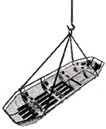 T
TA worker was buried with only his hand and wrist visible above the huge pile of dirt in a 15-ft-wide by 8-ft-deep trench that had just collapsed. "His buddies had a Ditch Witch about the size of the ones they use at a cemetery," says David Grice, an engineer with the Goldsboro Fire Dept. engine company that responded to the emergency. "They were about to crank it up and dig him out. But wary of possible consequences of that maneuver, Grice ordered the workers to turn the equipment off and step aside. "They would have killed him, he says.
 |  |
| Nick of Time. Rescue crews at a Goldsboro, N.C., sewer line cave-in saved a worker buried in a trench. Sometimes victims die later from complications of oxygen-starved muscles. | |
 |
Goldsboros small fire department wasted no time dispatching the engine company and a ladder company to the stricken construction site as soon as the call came in. The town did not have a special rescue unit at the time but Grice and another firefighter had been through trench rescue training. "The lieutenant hollered at me. I jumped in my pickup and followed the ladder truck, he says.
Grice saw trouble as soon as he arrived at the scene five miles away. There were no shovels. "I went back to a state Dept. of Corrections road crew I had just passed," he says. "I knew we needed their tools. By the time that crew was taken to the trench, first responders were already exhausted. They had been feverishly removing dirt with their hands.
The trapped worker, who officials cannot identify, was replacing the sewer pipe when the trench gave way. He had a shovel in his hand, which left enough of a void for rescue workers to give him oxygen. "We knew he couldnt breathe," says Grice. Tons of dirt knocked down the worker, who was lying on his side with his arm extended toward the surface. His face was covered with nearly two feet of mud. Grice and firefighter Ron Lee entered the trench to dig him out, but the space was too narrow for them to maneuver effectively side by side.
Grice then began digging toward the workers face and Lee toward his feet. "It was the first time any of us had done anything like that," says Grice. "We were all scared. I was afraid that something I did would kill him.
While Grice and Lee dug, other firefighters scrambled to reinforce the trench with whatever was available, including backboards normally used to transport victims with neck injuries. Other rescuers monitored the site for dangerous gases. Rescue officials on the scene ordered Grice and Lee to hook themselves to tag lines so they could quickly be pulled from the trench if there was further collapse.
Ironically, some of the firefighters response actions appear to contradict recommended practices in their profession and could have jeopardized the rescuers own safety. Grice remembers jumping into the trench and digging before shoring was in place. "I would do everything I could in a rescue," he says. "If there were no signs of life, maybe we would have waited for the shoring."
Grice defends his choices, noting the situation was a rescue, not a recovery. "There are some things you never forget," he says. "For me, it was seeing that guy trying to dig himself out with his exposed hand.
It took 15 minutes to dig out the workers face and chest and another 30 minutes...
rained rescuers say there is little that most construction workers can do for a colleague trapped in a collapsed trenchuntil the professionals arrive. That reality was more than evident when firefighters arrived at a sewer line construction site in Goldsboro, N.C., on June 27, 2003.
Post a comment to this article
Report Abusive Comment